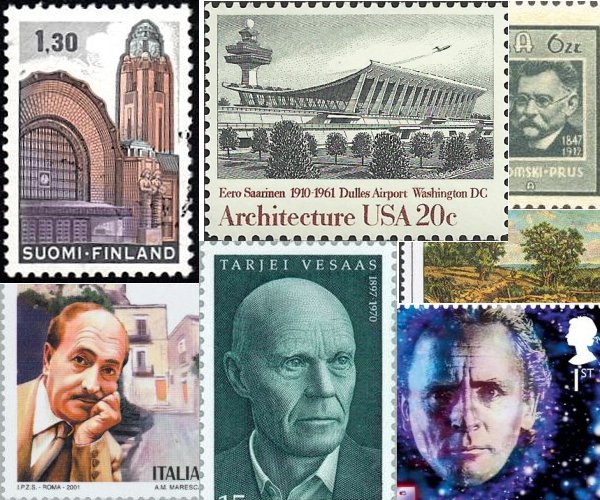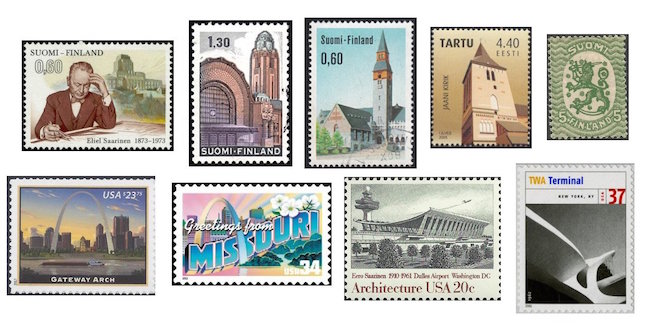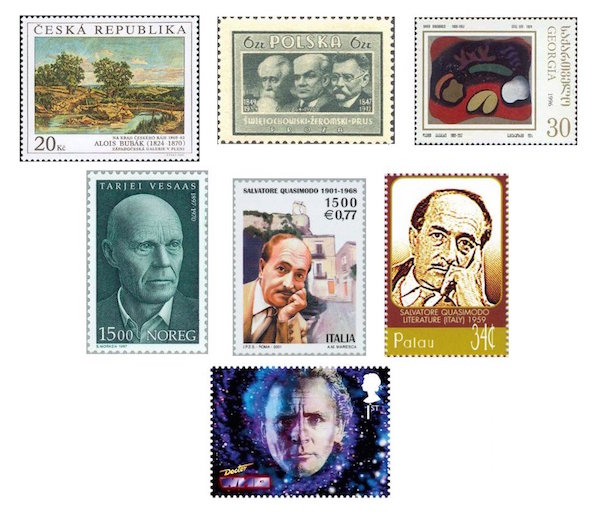The Arts on Stamps of the World — August 20
An Arts Fuse regular feature: the arts on stamps of the world.

By Doug Briscoe
Funny thing. Less than a week ago I mentioned that the French artist Claude-Joseph Vernet and his son Carle shared a birthday. The same is true of two Finnish architects, Eliel and Eero Saarinen. Eliel Saarinen was born on this date in 1873. Two of his best known works in Finland are seen on stamps: the Helsinki Central Railway Station (1910-14) and the Finnish National Museum (1905-10—a collaborative effort). In modern Estonia (as well as on a stamp) one can see his Church of St. Paul in Tartu (1911-17). Eliel Saarinen was also involved in city planning (not only in Finland, but also in Reval, Estonia and Budapest) and designed tapestries, furniture, pottery, and Finnish currency (banknotes of 1909-22) and postage stamps, including one that formed a long series beginning in 1917 (the solid green stamp is the first of these). Leaving Europe for the United States in 1923, Saarinen taught at the University of Michigan and at Cranbrook Academy of Art, where his students included Ray and Charles Eames, and of which he became president in 1932. Of course he continued his work as an architect, giving us among numerous others the Kleinhans Music Hall (1940), home to the Buffalo Philharmonic Orchestra (son Eero also worked on this project), and the Des Moines Art Center (1948).
Eero Saarinen (August 20, 1910 – September 1, 1961) was born on his father’s 47th birthday. His name is better known to most Americans than is that of his father, as the younger Saarinen’s projects included the Gateway Arch in St. Louis, Missouri (designed 1947, built 1963-65), the main terminal of Dulles International Airport (1958), and the TWA Flight Center (opened 1962), all three of which have been memorialized on U.S. stamps. Like his father he designed furniture, exemplified by the so-called Womb Chair (1947-48) and the “Tulip” or “Pedestal” chairs and tables.
The son of a woodcarver, Czech landscape painter Alois Bubák (August 20, 1824 – March 6, 1870) switched from theology to art and to the Prague Academy. Besides his many paintings, he also contributed illustrations to magazines. The work we see on the stamp is On the edge of Bohemian Paradise (Na kraji Českého ráje, 1860-62).
Polish journalist and novelist Bolesław Prus (20 August 1847 – 19 May 1912) was born Aleksander Głowacki and orphaned by the age of nine. Brought up for the next few years by his uncle, he joined the Polish uprising against Imperial Russia at 15 and was severely wounded the next year, then imprisoned for two months. It’s thought that these experiences resulted in his later panic attacks and agoraphobia. Unable to complete his university education because of a shortage of money, he worked in the Forestry Department until getting a job as a newspaper columnist in 1872. It was at this time that he adopted the pen name Prus, derived from the name for his aristocratic family’s coat of arms. His journalistic focus for the next forty years would be on science and technology, education, economics, and culture. In the meantime he turned to writing short stories and in 1886 wrote the first of his four novels. His only stamp, it appears, is one he must share with two other Polish writers, Alexander Świętochowski and Stefan Żeromski. Prus is at right.

Next we come to the Georgian painter and scenic designer Davit’ Kakabadze (August 20, 1889 – May 10, 1952), who also worked in cinematography. Through the generosity of local philanthropists, Kakabadze was able to attend St. Petersburg University, from which he was graduated in 1916. He lived in Paris from 1919 to 1927, exhibiting with other Georgian expatriates Lado Gudiashvili and Chalva Kikodzé. He experimented with a variety of media and invented a camera that simulated 3D. Also an art scholar, he returned to Georgia to teach, but after twenty years was dismissed from his post for his refusal to accept Socialist Realism. He died four years later. An example of his work is Abstraction (1927) on the Georgian stamp of 1996. He also filmed a documentary called The Old Monuments of Georgia (1931).
Norwegian novelist Tarjei Vesaas (20 August 1897, Vinje – 15 March 1970) was married to the writer Halldis Moren Vesaas, whose stamp we’ll see here in November. He wrote in Nynorsk, which helped to establish it as a literary language. (We dealt with this in our discussion of Ivar Aasen earlier this month.) He did not serve in World War I, but its effects had a lasting influence on his writing with its tendencies toward angst, guilt, and solitude, but also a love of nature and its healing qualities. Nominated on numerous occasions for the Nobel Prize, Vesaas’s best known works include the novels The Great Cycle (Det store spelet, 1934), The Seed (Kimen, 1940), and The Ice Palace (Is-slottet, 1963), which last is scheduled for reissue in English this December. He also wrote poetry and plays.
Our next writer, Salvatore Quasimodo (August 20, 1901 – June 14, 1968), did win the Nobel Prize for Literature in 1959, although it was his poetry that was specifically cited on that occasion. Just as Vesaas was deeply affected by the destruction of World War I, so young Salvatore was forcefully struck by the consequences of an earthquake in his native Sicily. He founded a journal in 1917 for the publication of his own poems, but the enterprise failed, and Quasimodo turned to a career as a draftsman and engineer. But wherever he went (he lived in Florence, Genoa, and Milan) he maintained ties with the literary community. From 1938 he was able to devote himself to writing. He also wrote novels and made numerous translations from the classics (Homer, Catullus, et al.).

It’s been a while since we’ve had a Doctor Who. Scottish actor Sylvester McCoy (born Percy James Patrick Kent-Smith on 20 August 1943) played the good doctor in the years 1987 to 1989. He was the seventh in the series of actors to portray the character. Much more recently, he took on the role of Radagast the Brown in Peter Jackson’s Hobbit films. His extensive work on the stage has included one-man shows about Stan Laurel and Buster Keaton.
Just a passing note to honor that master of the eldritch, the unspeakable, the horrors that grope and slither and gurgle beyond the outermost reaches of human sanity, H. P. Lovecraft (August 20, 1890 – March 15, 1937).
A graduate of the University of Massachusetts with a B.A. in English, Doug Briscoe worked in Boston classical music radio, at WCRB, WGBH, and WBUR, for about 25 years, beginning in 1977. He has the curious distinction of having succeeded Robert J. Lurtsema twice, first as host of WGBH’s weekday morning classical music program in 1993, then as host of the weekend program when Robert J.’s health failed in 2000. Doug also wrote liner notes for several of the late Gunther Schuller’s GM Recordings releases as well as program notes for the Boston Classical Orchestra. For the past few years he’s been posting a Facebook “blog” of classical music on stamps of the world, which has now been expanded to encompass all the arts for The Arts Fuse.
